The man who discovered Tutankhamun's tomb spent 10 years documenting the thousands of artefacts buried with the boy king. But his research lay neglected for decades. Jo Merchant meets the team of Oxford archaeologists finally revealing Howard Carter's secrets to the world.
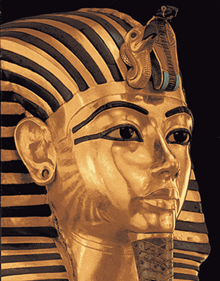 From the circular main hall of the Sackler Library in Oxford, an unassuming corridor leads to a staircase that takes you down below street level.
From the circular main hall of the Sackler Library in Oxford, an unassuming corridor leads to a staircase that takes you down below street level.
Through a door marked "archive", office ceiling tiles and fluorescent lights stare down on a cheap blue carpet and a row of grey rolling stacks. The hum of the air-conditioning lets slip that this ordinary-looking room is hiding something special.
The temperature is held at 18.5C, several degrees cooler than the sunny July day outside, while a humidifier keeps the moisture level tightly controlled. For those grey stacks contain the forgotten secrets of the most famous find in Egyptology, if not all of archaeological history: the tomb of Tutankhamun.
This is the Griffith Institute - arguably the best Egyptology library in the world.
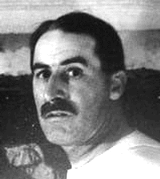 One of its most prized collections incorporates the notes, photographs and diaries of the English archaeologist Howard Carter, who discovered Tutankhamun's resting place in 1922. The only intact pharaoh's tomb ever discovered, it contained such an array of treasures that it took Carter 10 years to catalogue them all. Yet despite the immense significance of the discovery, the majority of Carter's findings have never been published, and many questions surrounding the tomb remain unanswered.
One of its most prized collections incorporates the notes, photographs and diaries of the English archaeologist Howard Carter, who discovered Tutankhamun's resting place in 1922. The only intact pharaoh's tomb ever discovered, it contained such an array of treasures that it took Carter 10 years to catalogue them all. Yet despite the immense significance of the discovery, the majority of Carter's findings have never been published, and many questions surrounding the tomb remain unanswered.
Jaromir Malek is the soft-spoken keeper of the archive whose own Tutankhamun project is nearing completion. By making all of Carter's notes available online, Malek wanted to ensure that the public would have access to the full extent of the discovery - and to spur Egyptologists into finishing the job of studying the tomb's contents. He has ended up creating a model that other researchers hope will transform the field of archaeology.
The effort has taken even longer than Carter's gruelling excavation. It began in 1993, when Malek says he realised that fewer than a third of the artefacts from Tutankhamun's tomb had been properly studied and published, a situation he describes as "unacceptable".
A total of 5398 objects were found in the tomb, covering every aspect of ancient Egyptian life, from weapons and chariots to musical instruments, clothes, cosmetics and a treasured lock of the royal grandmother's hair. A few, like Tutankhamun's gold burial mask, are instantly recognisable, but many are not well known, even to experts.
Part of the reason is that Carter died in 1939, just seven years after the excavation ended, and before he could fully publish his findings. "He started working on the final publication, but he was physically and mentally exhausted after a very hard 10 years," says Malek.
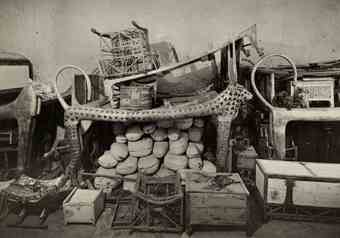 By all accounts a difficult man to work with, Carter had no collaborators left to continue his work when he died. And while the artefacts themselves are held in the Museum of Egyptian Antiquities in Cairo, Carter's notes were donated to the Griffith Institute, where they have lain largely undisturbed ever since.
By all accounts a difficult man to work with, Carter had no collaborators left to continue his work when he died. And while the artefacts themselves are held in the Museum of Egyptian Antiquities in Cairo, Carter's notes were donated to the Griffith Institute, where they have lain largely undisturbed ever since.
The sheer size and importance of Carter's haul seems to have discouraged scholars from tackling it. "I often say that the real curse of Tutankhamun is that Egyptologists have tended to shy away from working on the material," says Marianne Eaton-Krauss, an expert who has written three books about objects from the tomb. "These pieces are beautifully made. To study them takes a lot of work, and requires expertise not only on the symbolism, but also the technology."
So Malek decided that the best way to ensure that Carter's discoveries saw the light of day was to post the entire archive online.
"We can't make Egyptologists work on the material if they are not inclined to do so," he says. "But we could make sure that all of the excavation records are available to anyone who is interested. Then there will be no excuse."
A simple idea, but still a daunting task, particularly as a lack of funding meant that Malek and his handful of staff had to carry out the entire project in their spare time.
Carter recorded his finds on more than 3500 densely written cards, with additional notes by Carter's chemist and conservator Alfred Lucas, and more than 1000 images taken by his photographer, Harry Burton. There are also around 60 maps and plans of the excavation site, plus hundreds of fragile pages from Carter's journals and diaries.
A succession of secretaries scanned and transcribed Carter's notes between other work, then Malek proofread the results at evenings and weekends. Jonathan Moffett, head of IT at the affiliated Ashmolean Museum, built a database that could hold images of the original material as well as transcripts, so the text could be easily searched. In 1995 the team started posting the records in one of the first websites dedicated to Egyptology.
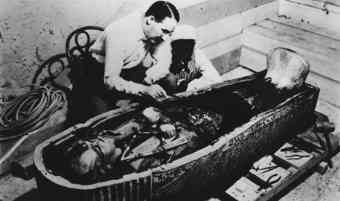 They called it Tutankhamun: Anatomy of an Excavation. More than 15 years later, the internet has been transformed: a Google search for Egyptology now returns more than three million results. And Malek's project is almost complete. Around 98 per cent of the material is available, with the last pages to follow within the next three months.
They called it Tutankhamun: Anatomy of an Excavation. More than 15 years later, the internet has been transformed: a Google search for Egyptology now returns more than three million results. And Malek's project is almost complete. Around 98 per cent of the material is available, with the last pages to follow within the next three months.
Among the highlights is Carter's diary from the period in which he discovered Tutankhamun's tomb. When I ask to see it, Malek's assistant Elizabeth Fleming pulls the yellowed notebook from a stiff cardboard case, and with white-gloved hands settles it on a pillow on the table in front of me.
Funded by the Egypt enthusiast Lord Carnarvon, Carter had been searching the Valley of the Kings - ancient Egypt's royal burial ground - for seven years. A few objects bearing Tutankhamun's name had been found in the area and the two were convinced that his tomb lay somewhere beneath thousands of years' worth of limestone rubble. Yet season after season of arduous digging, during which their workmen cleared large areas of the valley down to bedrock, produced nothing.
Then, on November 4, 1922, the dig revealed a step cut into the rock of the valley floor, beneath the foundations of a group of huts. It was the beginning of a stairway that led to a walled-up doorway: Tutankhamun's resting place had been found.
Fleming shows me two words from the next day's entry - "seals intact" - the crucial sign that the tomb had lain undisturbed since the second millennium BC.
Carter's handwriting, in small, neat pencil, suggests a disciplined, down-to-earth man, not inclined to florid outbursts. A typical diary entry reads simply "two donkeys" - a reference to the transportation that Carter and his assistant took to the dig site each day. On Sunday, November 26 however, after his first glimpse inside the 3300-year-old antechamber, Carter could no longer contain himself.
As he peeped through a newly burrowed hole, he later wrote in his journal that "the hot air escaping caused the candle to flicker". As his eyes became accustomed to the light, "the interior of the chamber gradually loomed before one, with its strange and wonderful medley of extraordinary and beautiful objects heaped upon one another".
Strange ebony-black effigies of the king, gilded couches, exquisitely painted caskets, flowers, shrines, chests, chairs and chariots glinting with gold gave the appearance of "the property room of an opera of a vanished civilisation".
Fleming also shows me one of Carter's plans - the valley's contours, neatly conveyed in sparse yet graceful black-ink lines. The dig site was located in the deepest point of the valley, where floodwater dumps debris when it rains. This, along with the fact that the later tomb of Ramses VI was built almost on top of it, kept Tutankhamun hidden from robbers over the centuries, and from the wholesale dismantling of royal tombs by Ramses XI in the 11th century BC.
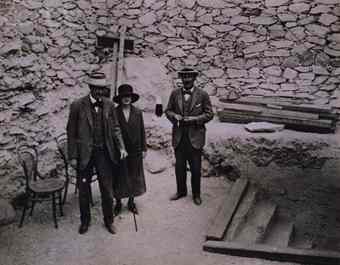 The real meat of the archive, however, is in the notes and photographs that record every item found in the tomb in painstaking detail. Any other archaeologist working in the 1920s might have bundled the treasures out of the tomb in mere hours, but Carter worked methodically and meticulously.
The real meat of the archive, however, is in the notes and photographs that record every item found in the tomb in painstaking detail. Any other archaeologist working in the 1920s might have bundled the treasures out of the tomb in mere hours, but Carter worked methodically and meticulously.
Burton's black-and-white photographs show the team's progress through the tomb, and these too are available online. Despite the difficult lighting conditions, these images - acknowledged as some of the best in archaeology - capture the eerie stillness of the tomb when it was first opened. Chairs and chariot wheels appear to have been casually propped against the wall, while statues stand in their linen shawls as if placed there hours before.
I'm struck by how messy and jumbled the objects look. This is partly because Tutankhamun died unexpectedly, so his belongings had to be crammed into a much smaller tomb than would have been intended, and partly because the tomb was robbed shortly after the unfortunate king was buried and the guards seem to have done a rather careless job of righting the ransacked contents before resealing the doors.
"We can see things [are] missing," says John Taylor, who looks after the Egyptian mummies collection at the British Museum in London.
"We have the plinths for gold statuettes but not the statuettes themselves. They broke the gold fittings off furniture. And we can see fingermarks inside a jar where a robber stuffed his fingers in and scooped out a sticky mass of very valuable scented oil."
Burton's photos document each artefact after its removal from the tomb: a quick browse of the database reveals some charming treasures - from a leopardskin cloak with a golden head and silver claws to a collection of green and blue draughtsmen and even a folding bed. A search for "mummy" returns 68 photos taken at various stages of the unwrapping process, from plump outer bandages to fragile bone.
For Malek, a principal aim of the project is to bring the forgotten details of the tomb to as many people as possible.
"We felt this was important because the discovery is so well-known," he says.
"This doesn't belong to Egyptologists only, or even to Egypt only. Everybody should have the right to see what's there."
Taylor agrees that the failure of Egyptologists to publish the discovery in its entirety has left the public in the dark about much of what was in the tomb.
"A lot of the objects will be very unfamiliar to people," he says. "What is needed is for schools and people with a more general interest to have access to the basic data and see what's there."
In this, the website appears to be succeeding. It has informed countless school projects and even an interactive DVD being produced by the BBC to accompany an Egypt-themed episode of Doctor Who. Semmel, the German event promoter, has used Carter's technical diagrams to make exact replicas of many of the treasures from Tutankhamun's tomb for an exhibition that is currently touring Europe.
But Malek also hopes to put "moral pressure" on Egyptologists, to encourage them to study this immensely important collection.
"Tutankhamun's is the only royal tomb that we have that wasn't gutted by tomb robbers. If we want to know what an Egyptian pharaoh took with him to the afterlife, it's the only one we can look at," says Malek.
"Nothing in the tomb was accidental. We will not be able to understand the tomb as a unit until all of the objects are properly explained."
Egyptologists are particularly excited about what the objects from the tomb can tell us about the technology of the ancient Egyptians.
"We can study how these objects were made, the materials and techniques that were used," says Malek.
"That is quite rare. There is a great difference between being able to look at a representation of a chair on the wall of a tomb or a temple and being able to study that particular object in reality."
Carter's archive is a useful source of back-up information but it also provides a lot of data that would be difficult or impossible to glean from studying the objects in a museum today.
For a start, Carter recorded exactly where items were found in the tomb, and how they were positioned relative to each other. "It seems like just a pile of things, but there is a system," says Malek.
Eaton-Krauss recently used the website in a study of how Tutankhamun was buried. She was able to tell from Carter's excavation journal that the innermost shrine of Tutankhamun's tomb was too small to fit properly around his sarcophagus, suggesting that the sarcophagus had, in fact, been intended for someone else - something that it is impossible to tell from the objects as they are set up on display in Cairo.
Sitting in front of those grey rolling stacks, Malek tells me that after going through every single page of Carter's excavation notes he has a new appreciation of the archaeologist's strength of character.
"He was not easy to work with," says Malek. "He was quite often short-tempered, perhaps not always tactful. But what I find really impressive is that there was this massive task, and in spite of all the difficulties, he finished it." Something that Malek himself hopes to live up to within the next few months.
What killed Tutankhamun?
Tutankhamun came to the throne as a young boy and ruled for just nine years before he died, aged 18 or so, the victim of an early - and likely violent - death. His early demise has sparked intense speculation about what killed him.
The mummy was first unwrapped in 1925 by Douglas Derry, an anatomist, but the poor state of the remains meant that he was unable to suggest a cause of death - much to Howard Carter's disappointment. In 1968, anatomist Ronald Harrison took a series of radiographs of the mummy.
Signs of trauma to the back of the head and an unhealed broken leg led to speculation the king had been kicked by a large beast, or even murdered. In his 1990 book The Complete Tutankhamun, the archaeologist Nicholas Reeves suggests he was killed by his adviser, Ay, who became king after Tutankhamun's death.
This year, after x-rays and genetic analysis, Egypt's chief archaeologist Zahi Hawass concluded that an inherited bone disorder had weakened the king before an attack of malaria finished him off. But German geneticists recently suggested that the bone damage might have been caused by sickle cell disease.
Robert Connolly, an anatomist who worked on Harrison's 1968 study, points out that inherited disease does not account for the extensive damage that Tutankhamun's body suffered. Connolly believes that the young king died violently, most likely in a hunting accident.
Howard Carter's research and photographs can be found here.
Source: New Zealand Herald [August 09, 2010]